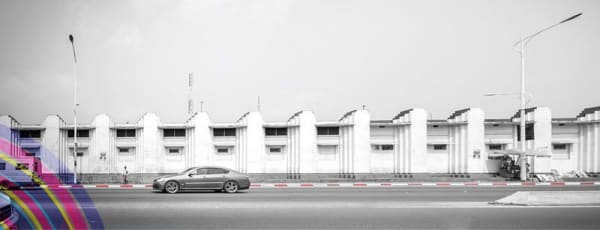Firoz Mahmud's works often draw artistic themes from the history of the Bangladeshi region in which he is deeply rooted, and where many historical cities have been transformed by colonialism. A distinct number of Mahmud's works look at Uponibeshik (colonial) and Poruponibeshik (post-colonial) narratives of Bangladesh and its capital city of Dhaka which was formerly known as Jahangir Nagar.
Mahmud coined the term 'Layapa Art' to describe his paintings that employ a technique that he researched on during a residency program at Rijksakademie VBK, Amsterdam in 2003/2004. The word 'Layapa' is from the Bengali language and means 'to anoint or plaster'. The women of rural Bangladesh use a meticulous technique to finish the walls of their village huts with clay. The artist sought inspiration from this as well as other cultural practices such as the Japanese Ukiyo-e woodblock printing. The end result is a hybridized stencil and layering technique which forms part of the foundation of Mahmud's art practice. Such aspects of cultural heritage may have gotten devalued or undermined through the mechanisms of colonialism that affected many nations from the 17th to the 20th centuries.
Mahmud's works are largely informed by his ongoing interest in historical narratives and artistic devices in story-telling. He uses idioms such as old palaces, forts, spice trees or herbaceous plants, wild animals and colonial traders in these drawings and carvings, addressing the riches of his native land. Mahmud juxtaposes themes of socio-political culture, tradition, history, and myths that beg the question of how they exist today, and what forces have created new visual territories, impacting how we remember our own cultural histories and those of our neighbours.
Firoz Mahmud (b. 1974) was born in Khulna, Bangladesh and completed his BFA and MFA at the Dhaka University's Institute of Fine Arts before attaining a PHD in Fine Arts from the Tokyo University of the Arts. He has completed residencies at the Rijksakademie VBK, Amsterdam, and the International Studio and Curatorial Program in New York. Mahmud’s paintings and installations examine the socio-political culture, tradition, history, myths and pop culture of his native land. His most notable works have been featured in group exhibitions at “HEAT” Ota Fine Arts, Tokyo (2017); “The Missing One” The Office for Contemporary Art Norway, Oslo, Norway (2016); "Aichi Triennale 2010: Arts and Cities", Aichi, Japan (2010); "The 9th Sharjah Biennial" Sharjah, UAE (2009); and "The 11th International Cairo Biennale" Cairo, Egypt (2008).
-

菲罗兹・马哈茂德 “Art, Artists & You” 儿童博物馆、曼哈顿、纽约
2019年9月14日菲罗兹・马哈茂德目前于儿童博物馆(曼哈顿、纽约)参与“Art, Artists & You”。展期为2019年6月8日(六)起至2019年12月31日(四)。 展览信息...阅读更多 -

菲罗兹・马哈茂德 “Vantage Point Sharjah 7” Sharjah Art Foundation,阿联酋
2019年7月23日菲罗兹・马哈茂德参与阿联酋Sharjah Art Foundation所举办的群展“Vantage Point Sharjah 7”,展期为2019年7月6日至10月6日。 展...阅读更多 -

菲罗兹・马哈茂德 “刚果双年展”,刚果民主共和国
2019年7月23日菲罗兹・马哈茂德将参与在刚果(金)举办的“刚果双年展”,展期为2019年10月20日至11月21日。 展览信息 展覧名称 : 刚果双年展 展期 ...阅读更多 -

菲罗兹・马哈茂德 “Not Just Another Pretty Picture” Berkshire Art Museum,马萨诸塞州
2019年6月12日菲罗兹・马哈茂德将参加美国马萨诸塞州Berkshire Art Museum 的群展“Not Just Another Pretty Picture”,展期2019年6月27日...阅读更多






